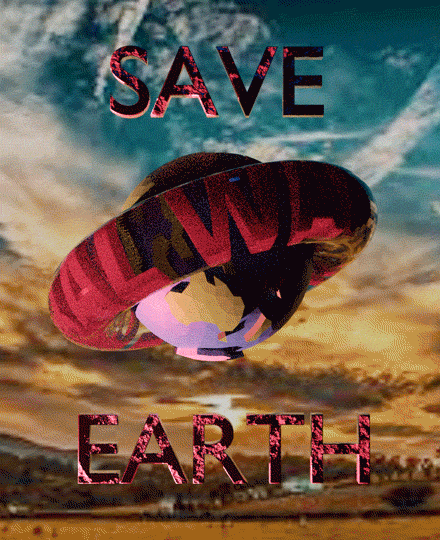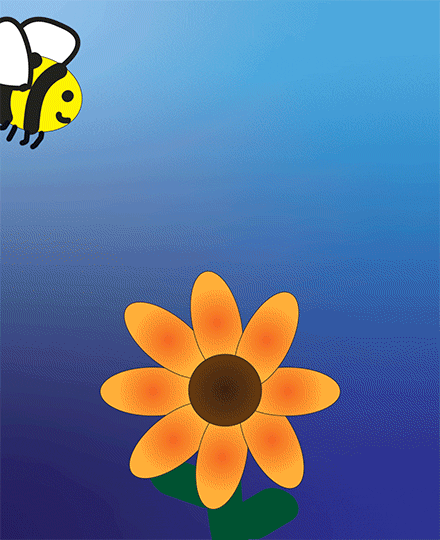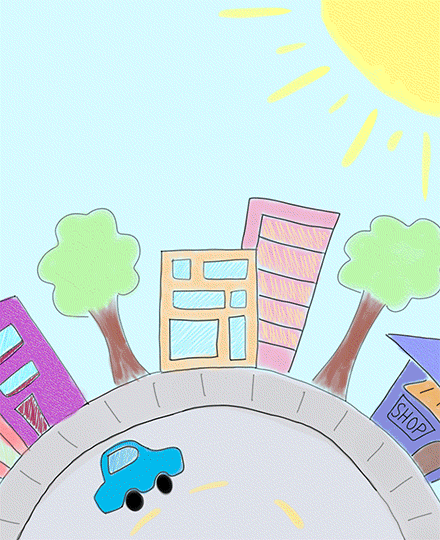Our World: Nancy Zhu interviewed by Serena Jankovic

Serena Jankovic: Alright, thank you for joining us today Nancy. I am so excited to talk about your piece. Can you start out by explaining to us what your vision is for the piece?
Nancy Zhu: Yeah, so. When I first started the project, I had a couple of ideas that were displayed in my rough drafts. I thought about things that were close to me. So, first it was like the Chinatown Area construction and protesting that. But then I realized that I am not immediately a part of the community so am unable to represent the community’s experience. Then I stumbled upon this idea about global warming because everyone on this planet is experiencing it to some degree and it is something that is very important and has been more prevalent throughout the years in the media and so forth. So my vision for this, I actually came in with no particular vision at all. I was just brainstorming but I knew that I wanted to do something in regards to global warming. So yeah, I just went into Blender and started playing around with things. I compiled a couple of things and iterated until I found something that looked good in my opinion and conveyed the message.
SJ: I will say that when I first looked at it, it was very striking with the words global warming rotating is really cool and the background feels almost dystopian with the colors that were used there and the font. I guess I am just wondering what message you hope to convey to viewers. Like what do you hope they feel when they see this?
NZ: Yeah, it is exactly that. I think I tried to be very intentional with the font, the lighting, and also the background choice because I wanted the message to be clear that if we don’t do something about this, there is no other viable earth that we have found thus far. And it is very real that this world can become a dystopia and if we just don’t take care of Earth, Earth itself will, like you know, die in some way. And that is represented through some of the letter choices. I was trying to make some lava letters so it kind of glows. And also the choice of red is very alarming so that is where that came from as well.
SJ: Very cool! I love how you have the Earth kind of floating in the scene. It almost makes me think about Saturn and the dystopian aspect of Space or other planets. Did that come up or play a role?
NZ: It definitely wasn’t intentional but yes, I definitely got the feel with the rings and so forth. But I think in any planet, it can be the case where, not directly global warming but there can be some sense of destruction on any planet or mass that you are on. It wasn’t intentional, but I think it adds to the space and dystopia of the piece where there is a sense of almost a greater world out there. But ultimately Earth is where WE are at so it is important to keep it alive.
SJ: Yeh, I love it! I guess we are coming to the end of our time here but is there anything else that you would like to leave with the audience?
NZ: Yeh, I want to say please, please be gentle with the Earth. We only have one and there are many generations to come. This is not only our problem presently but it will continue to be a problem that evolves. So for future generations to come, it is important for us to act now as it is something that is continuous. So please be kind to the Earth!
Sophie Nadel interviewed by Nancy Zhu

Nancy Zhu: How has your day been?
Sophie Nadel: Pretty good. Actually, I’m just procrastinating, I guess. I have a lot of emails and stuff…did not see any bees today.
NZ: Okay, that’s fair. It’s been a little rainy recently. I’m kind of curious, what has been your inspiration? Like, how did you come about picking your topic?
SN: Yeah, sure. So first, I was trying to think about how I could create like a really meaningful poster with a really poignant social issue. And then I couldn’t think of one that felt right for me to represent, that felt like I had enough of a stake in it or that I was in the position to say the most about it. I looked at the assignment again and saw that it was like, “Or [the poster] can just be kind of fun, and be something you’re interested in.” And I like bees, because bees are very cool, and I just decided to just, you know, make a poster about saving bees. Which is, also, an environmental issue.
NZ: That is very true. It is certainly an environmental issue, and I think it’s a big one. I don’t even know, fully, the extent to which bees help our environment…
SN: Oh, they’re vital. They’re essential. We need the bees to eat.
NZ: Oh, like for pollination?
SN: Yes.
NZ: Very cool, very cool. I’m also kind of curious about like, what your process was like. Did you go through several iterations? How did you figure out the composition and overall design, as well as the message you wanted to send specifically in regard to bees?
SN: So I played around with some designs — I wanted to go for something with a nice overload of bees and apiary feeling. I had one prototypical poster that was just a bunch of bees kind of going back and forth to have a fun little colony moment. But then, I also liked the idea of doing an animation of a single bee coming down to pollinate a flower and thought that that would be more fun to animate because there’s a few more different things going on. And I had this picture in my head about it and thought it would look nice to have a gradient-like blue sky and a spinning flower. That is just exciting. My first version just had the word “bees” appear and blink in and out around the poster — like, “bees bees bees bees” — but then Avery said that I didn’t need that to convey my message. So I was like, yeah I guess if I have one bee, all the focus could be on that little round guy.
Stroad to Hell: Serena Jankovic interviewed by Sophie Nadel
Created after Serena discovered an interest in urban planning, Stroad to Hell explores the failures of post-war North American development, highlighting one pitfall in particular: the stroad. The term “stroad” was coined by Strong Towns, a non-profit organization that seeks to replace America’s post-war pattern of development with new, financially strong, resilient, and safe methods. Stroads are the expansive, multilane thoroughfares that are not only dangerous to pedestrians, wildlife, and other drivers, but financially unproductive. Through a playful but direct, colorful animation, Serena seeks to spread awareness about the term “stroad” while urging her audience to speak out for the community-based, safe, and prosperous towns and cities that can be. – Sophie Nadel

Sophie Nadel Thanks for joining us today! So first off, what’s your final vision for this poster?
Serena Jankovic So basically, the animation starts with a nice little city full of life: various shops, tall apartment buildings, and few cars on the road. It’s an environment made for pedestrians and community. The street and building rotate off the screen and are replaced by a Walmart, which crashes down from above. It’s supposed to be invasive and intrusive. Cars fill the screen, there’s no more city life or space for pedestrians. A vibrant city is replaced with sprawl. It’s a message on how sprawl has taken over a lot of cities and suburbs in the US, but it’s specifically a message on the stroad, which is essentially a failed version of both a street and a road.
SN I’ve never heard of there being a difference between a street and a road. It’s very interesting that they’re getting combined now, which if they’re getting combined, that means there had to have been a difference in the first place. So what would you say is the difference between a street and a road?
SJ So a street is what you might think of when you imagine the downtown area in a city. It’s the heart of a city. There’s a lot of life, dancing, and places to eat, people are walking around, and the shops come up basically right to the street, which is narrow so that cars don’t move too fast in this pedestrian–dominated environment. A road is a high-speed connector. It’s characterized by wide lanes and big signs so you can read them while driving fast. It’s kind of like what we think of to be freeways.
SN So what brought you to this specific inspiration of “streets, not stroads”?
SJ I actually learned about stroads myself last semester in a class. I thought it was really interesting and never realized there was a difference between a street and a road, either. I’m a big city person–I love being able to walk or bike to places. I don’t love American suburbs because you really just need a car to get anywhere, which can lead to so many socio-economic problems. I think that that also makes it really difficult to meet people or feel like you’re in a community, so I’m a big proponent of revamping American suburbs, and I wanted to spread awareness of this issue through this project.
SN Where are you from originally?
SJ I’m from a suburb in Connecticut, so I’m very used to having to drive everywhere and not having much independence until I could drive.
SN So was coming to Penn pretty different for you?
SJ Huge difference, but such a positive one. I love the mixed-use neighborhoods where you’ve got residential areas, but also businesses like restaurants or grocery stores sprinkled throughout so that you can just walk a block to get most of what you need. That’s definitely my ideal living situation, and I also feel like it’s better for community building. Like, when you’re walking down the street to pick something up from a convenience store, you can say hello to your neighbors eating at a cafe.
SN That does sound pretty great. Well, we’re sadly running out of time, but are there any final messages or words of wisdom you’d like to leave with our audience?
SJ I would say, yes, stroads are what we largely have in American suburbs. But it doesn’t have to be that way. The way to fix a stroad is to turn it into either a street or a road. There are places that have done this successfully, and Strong Towns has a lot of resources and information. I didn’t know what